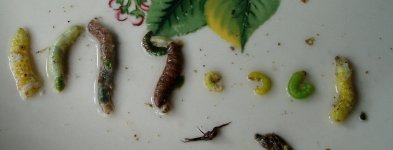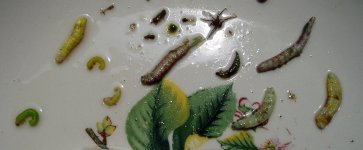P
PaulK
Member
- Joined
- May 18, 2011
- Messages
- 43
Hello,
I fished a favorite Northeastern Pa stream over the weekend, as I've done for the last 15 years for Memorial Day weekend. Saturday afternoon, heavy rain raised the stream by 1.5'. Now, I can't conclude that these stomach contents are the result of a high water event, but I guess I'm leaning toward that. On Sunday at noon, when I was able to get back in the stream, I did very well, but unfortunately killed one trout with a #4 Rubber Legs I was using. I tried to revive it, but no luck. So I took him, but examined his stomach.
I'm really surprised by the contents. All larva and a spider. No mayfly nymphs or duns or spinners. No caddis pupa, no stoneflies.
I can only guess the pink/brown larva are Cranefly (1.25 to 1.5" long). The bright green one might be an inchworm. There's a classic dark green caddis larva. But check out the yellow larva,--the two identical little ones and the two identical big ones--and the lime green one. Who knows what the stomach juices did to the coloration, but they don't look too digested. Maybe they were cream to start. I guess my biggest question is, why did all these larva show up in the forefront of this trout's stomach? Was it the high water and/or some invertebrate drift overnight, in combination. I just question if I would have found these contents had the stream not flooded.
This has altered my ideas of what to fish after a heavy rain. Anyway, if anyone would like to try and identify these, please do.
I fished a favorite Northeastern Pa stream over the weekend, as I've done for the last 15 years for Memorial Day weekend. Saturday afternoon, heavy rain raised the stream by 1.5'. Now, I can't conclude that these stomach contents are the result of a high water event, but I guess I'm leaning toward that. On Sunday at noon, when I was able to get back in the stream, I did very well, but unfortunately killed one trout with a #4 Rubber Legs I was using. I tried to revive it, but no luck. So I took him, but examined his stomach.
I'm really surprised by the contents. All larva and a spider. No mayfly nymphs or duns or spinners. No caddis pupa, no stoneflies.
I can only guess the pink/brown larva are Cranefly (1.25 to 1.5" long). The bright green one might be an inchworm. There's a classic dark green caddis larva. But check out the yellow larva,--the two identical little ones and the two identical big ones--and the lime green one. Who knows what the stomach juices did to the coloration, but they don't look too digested. Maybe they were cream to start. I guess my biggest question is, why did all these larva show up in the forefront of this trout's stomach? Was it the high water and/or some invertebrate drift overnight, in combination. I just question if I would have found these contents had the stream not flooded.
This has altered my ideas of what to fish after a heavy rain. Anyway, if anyone would like to try and identify these, please do.






